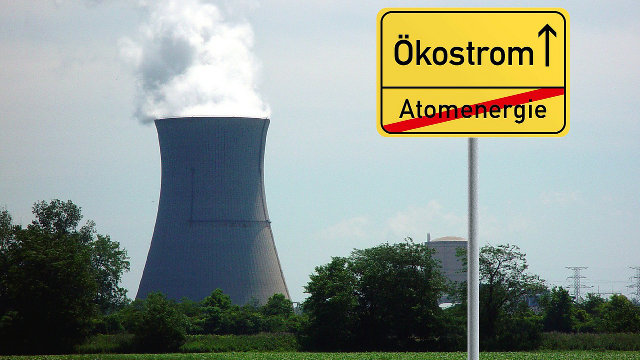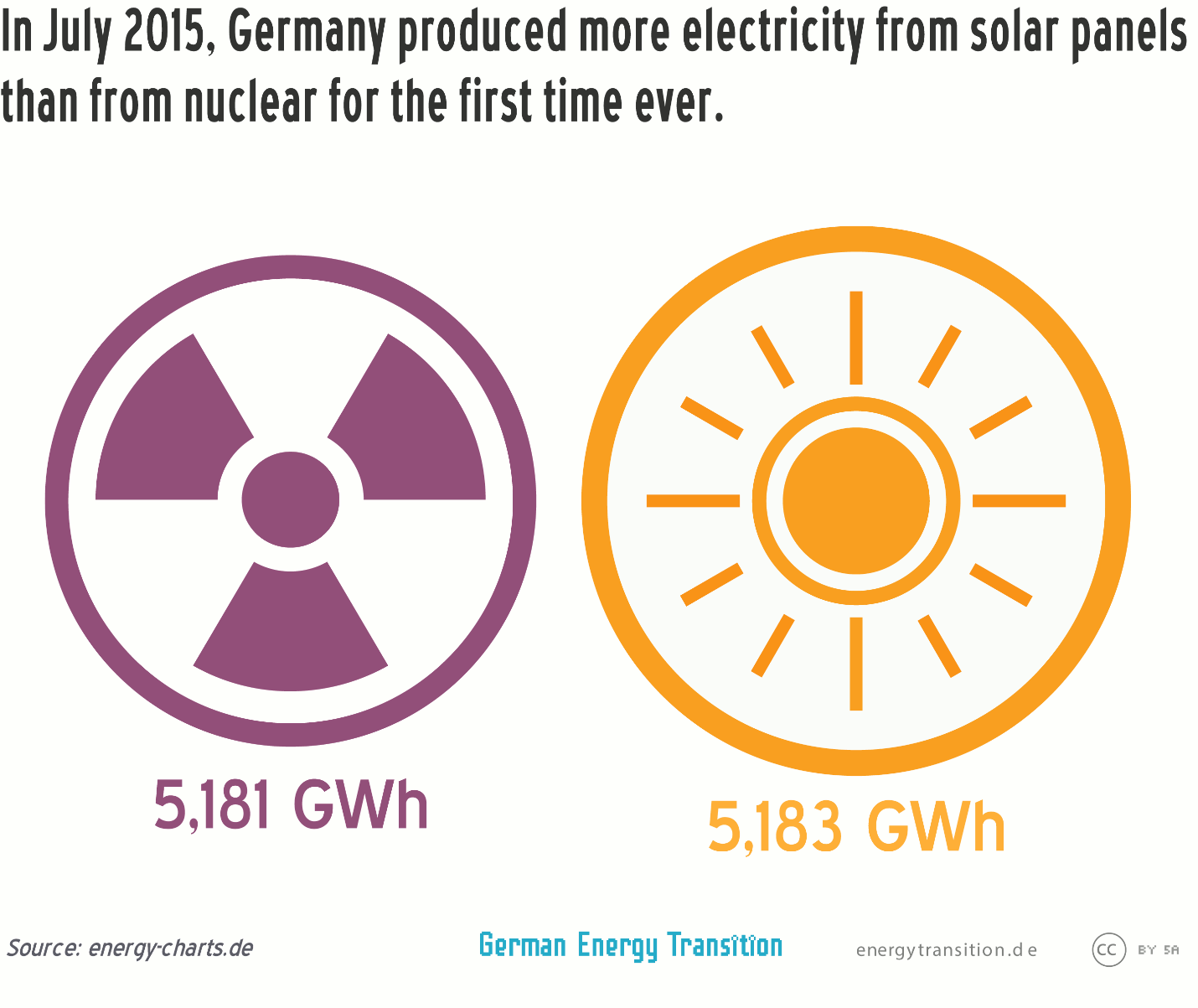In July, Germany may have had more solar power than nuclear power for the first time in history – much sooner than anyone expected. It was a close race, and nuclear is likely to retake the lead for the foreseeable future. Craig Morris explains.

Solar beat nuclear in a photo-finish.
Up to the end of July, the numbers were incredibly tight, but according to preliminary figures Germany produced slightly more electricity from solar panels than from nuclear plants.

Two effects were simultaneously at work. First, July was an especially sunny month. In July 2013, Germany produced 5.35 GWh of solar power, which is still the record. But back then, Germany also had nine nuclear plants in operation. In June, another nuclear plant was shut down for good. In addition, three nuclear plants were off-line for part of July for scheduled maintenance and refueling, leaving the country temporarily with only five nuclear plants. So the second effect was lower-than-usual nuclear power production.
“It would be nice if we could celebrate a surge in solar power rather than a reduction in nuclear,” my colleague Thomas Gerke, who created the chart above, stated when I asked him to make such a chart. Unfortunately, though new record in solar power production was set. Last week, it looked like the difference between nuclear and solar would be much greater, but the difference currently reported is paper-thin. Thomas had to add up all the daily numbers just to corroborate the small difference.
When I contacted Dr. Bruno Burger, who runs Fraunhofer’s Energy Charts website (where we got the information from), I asked him how preliminary the figures are. He said that, while the nuclear figures are quite exact, the solar numbers are partly extrapolated – and we will not know the final figures for last month until September 2016! “In my opinion, it is safe to say that solar and nuclear produced roughly the same amount of electricity last month, but not yet that solar produced more,” he stated.
As we enter the winter, solar power production will decrease, and power demand will gradually rise. The result will be more space for nuclear plants on the power market. Nuclear reactors are generally refueled in the summer, when power demand is low, so solar may again outstrip nuclear next summer. Or maybe not; the race was tight this year, and very little solar is being built at the moment.

The next nuclear plant will not go off-line until December 2017, so we may even have to wait until the summer of 2018 for more solar power than nuclear to be generated on a monthly basis again. But the writing is on the wall for nuclear power in Germany; by 2023, the country will have closed all its nuclear plants, so solar will then be bigger than nuclear in the country 12 months a year by then.
This new record is, of course, largely symbolic, but it is worth considering how much faster it came than anyone expected. Back in 2009, the German government itself did not expect to have the current level of installed PV until after 2050 (report in German, also see my previous report). Today, the country was expected to have only half as much solar installed. And in 2010, Chancellor Merkel extended the commissions of numerous German nuclear reactors into the 2030s. At that point, more solar than nuclear on a monthly basis may not have happened until the 2020s. Clearly, solar can grow much faster than anyone expected – and that is something worth celebrating.
Craig Morris (@PPchef) is the lead author of German Energy Transition. He directs Petite Planète and writes every workday for Renewables International.
With falling power prices (see the EEX, 2017 prices are rock bottom now) it is very likely that more atomic power plants will give up prematurely. So did the last in Grafenrheinfeld which closed a half year before it’s license did run out.
When Grafenrheinfeld closed down they slowly reduced the output using up what left on fuel:
http://www.nordbayern.de/region/feuer-geht-langsam-aus-akw-grafenrheinfeld-schaltet-ab-1.4461886
So week after week since Mai and through the month of July (when PV overtook the atom for the first time)the power output dropped.
Parallel to this power drop from Grafenrheinfeld other atomic power plants in Germany throttled down as well. They could not compete anymore, there was no demand for their power.
http://www.bloomberg.com/news/articles/2013-07-05/nuclear-cuts-vindicate-merkel-as-rwe-profit-dips-energy-markets
The knock-out times for the old bangers are increasing, the profit margins are falling very fast:
http://www.schaumburger-zeitung.de/portal/lokales/sz-heute_Atomkraftwerk-brechen-Einnahmen-weg-_arid,728119.html
Not only that 3 atomic power plants went into revision/repair/refueling modus in July with a zero-output – the other 5 reduced their output because there is a very good reason for it: money.
They are more and more frequently losing money on days with low power prices.
These days are on the increase, the atom power plants have to sell more and more power in the daily market, the times that the output could be sold years ahead are gone.
And according to EEX the number of day-ahed tradings are breaking one record after the other, are on a very sharp increase.
And we can expect further technical reduction of atomic power output in Germany from now on, the more powerful MOX-fuel is not being replaced anymore:
http://www.noz.de/deutschland-welt/niedersachsen/artikel/594308/letzte-mox-brennelemente-nach-niedersachsen-geliefert
The manufacturer of these fuel rods closed down.
As far as I understood the German fuel situation the atomic power plants show an increase in output when using MOX of about 1-2% (please correct me).
The serial defect of these MOX fuel elements forbids the new installation, more outages and therefore even less power output would be the consequence.
Old ones with less power in them are put back:
http://www.vorarlbergernachrichten.at/abend/2015/07/16/wieder-defekt-in-altem-akw.vn
So the guesstimate that we won’t see for a long time coming a repeating of PV power reigning above atomic power seems to me inconsequent when bringing the facts together:
Less output due to weaker fuel,
less running hours due to increased age,
more output reduction due to low power prices.
If we check Fraunhofer ISE data charts for the month of August (today is the 3rd of August) we can see 3 times as much PV power already being fed into the grid than atom power
https://www.energy-charts.de/energy_de.htm
PV installations are still done at around 100MW/month
PS
” market-induced stand-stills” are not only on the increase within Germany’s atomic power plant fleet.
The latest coal power plants feel the market forces as well:
http://www.welt.de/print/die_welt/hamburg/article143799860/Kraftwerk-Moorburg-laeuft-nicht-rund.html
Thanks for the extra info, heinbloed!
The title’s question
” Did German solar top nuclear for the first time?”
can be answered for sure: yes.
How much more PV power was fed into the grid is still to be figured out however.
Reason:
The EEX data used to calculate the PV-output is patchy, the major culprit is the utility/grid owner 50 Hertz.
Strange enough 50 Hertz is based in Leipzig, similar to the EEX. As if there wasn’t a cycling courier service available, never mind a telephone …
50Hertz has about the worst record on keeping the data flow near reality, near live results.
As I checked in July the
” Actual Solar Power Generation (chart)”
http://www.eex-transparency.com/homepage/power/germany-austria/production/usage/actual-solar-power-generation-
50 Hertz data for PV (in particular for PV !) was more than patchy, missing for days if not weeks.
Only to be added to the EEX-transparancy data base (guessed?!) after one or two weeks. So using present numbers from the EEX – as one would do on the 1st of August when checking the July PV-production – does almost certainly miss a few Eastern German PV-plant results from the last one or two weeks in July.
Today’s EEX-transparency data (today is the 9th of August) is missing PV-data to be provided by 50 Hertz from the 2nd of August (total miss)and from the 3rd and 4th of August (both patchy).
I expect that on the 1st of August when the check was done plenty of 50Hertz July data was missing as well.
It is the company’s modus operande not to provide RE data on time – as legally demanded.
50 Hertz is the worst culprit for RE-data, they are the lignite country’s transmission company.
I wonder what potential benefit the company (or their mother ship) has on this very obvious pattern.
They miss-out frequently on supplying PV data since a very long time.
About since a year.
Data transmission can’t be the problem, the EEX and 50 Hertz are based in the very same town and PV data arises during the daytime when cyclist couriers are offering their service. Trams and buses should be available then as well, just in case it rains …:)
Yesterday PV overtook atomic power in Belgium for the first time, 5 of the 7 bangers are knocked out at the moment:
http://www.demorgen.be/wetenschap/heropstart-tihange-3-uitgesteld-tot-morgenavond-a2422976/
“De stopzetting van reactor 3 leidde donderdag in de loop van de dag trouwens tot een uitzonderlijke situatie waarbij er, even na 14 uur, in ons land meer energie opgewekt werd met zonnepanelen dan met kernenergie. Dat bevestigde hoogspanningsnetbeheerder Elia, die spreekt over een “uitzonderlijke situatie”, wellicht onuitgegeven in België. Kort na 14 uur lag de productie van de zonnepanelen op zo’n 1.900 MW, terwijl die van de kerncentrales uitkwam op 1.400 tot 1.500 MW.”
Google translate:
” The shutdown of reactor 3 Thursday resulted in the course of the day the way to an exceptional situation where there just after 14 am, in our country more energy generated by solar panels or nuclear energy. That confirmed transmission system operator Elia, who speaks about an “exceptional situation”, probably unpublished in Belgium. Shortly after 14 o’clock was the production of solar panels at about 1,900 MW, while that of nuclear power plants stood at 1,400 to 1,500 MW. “